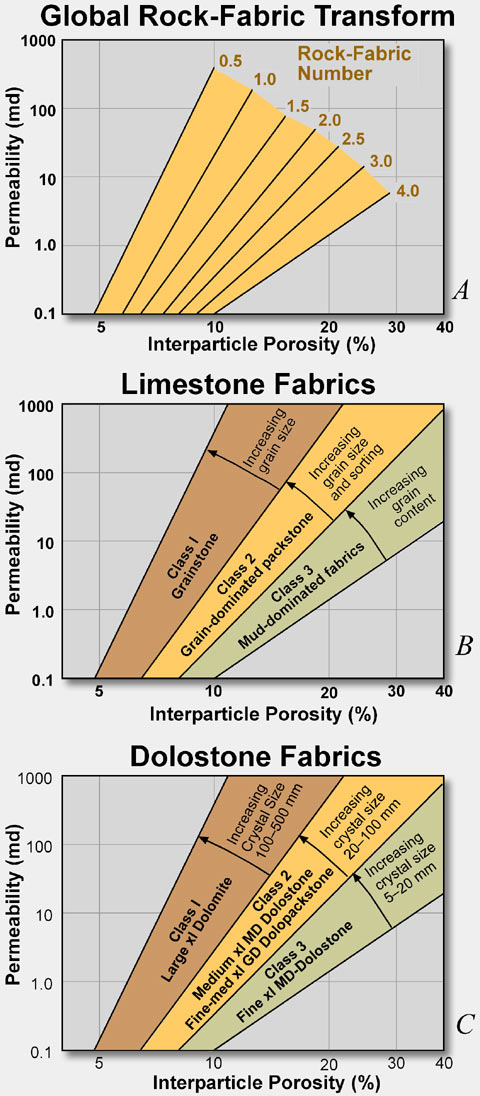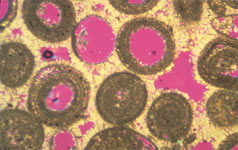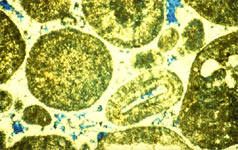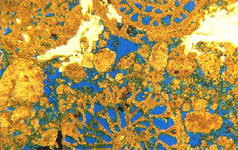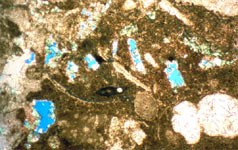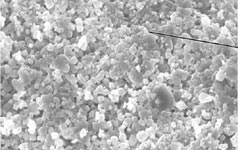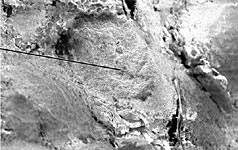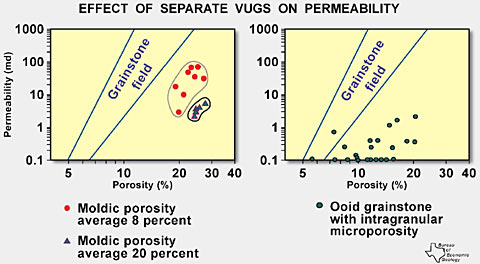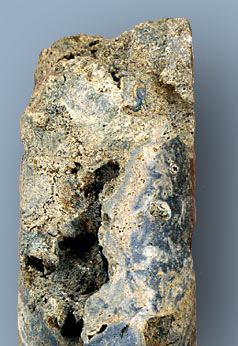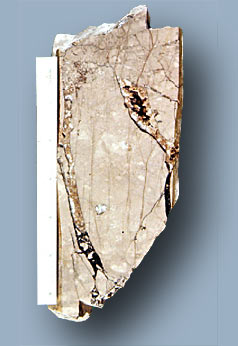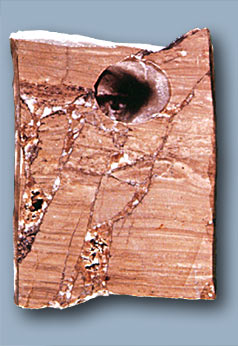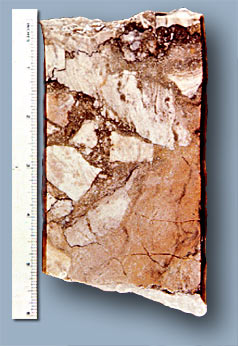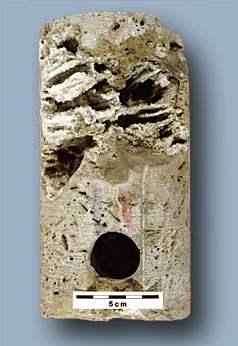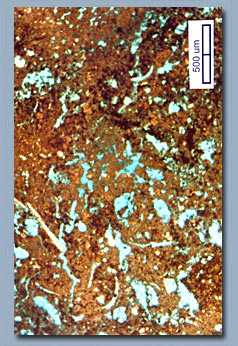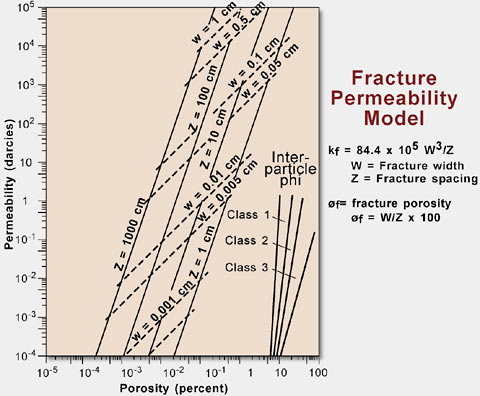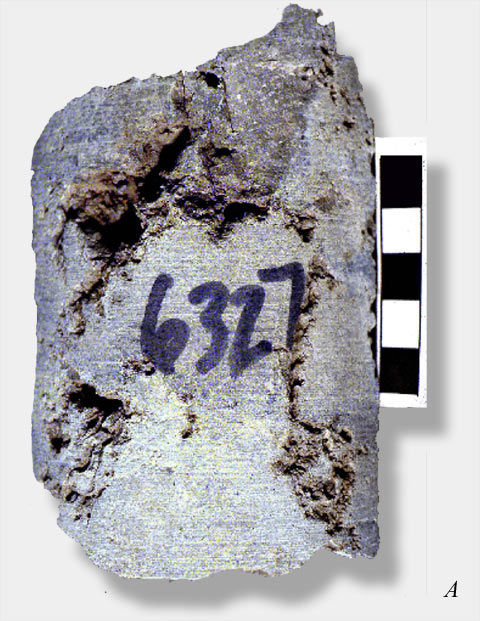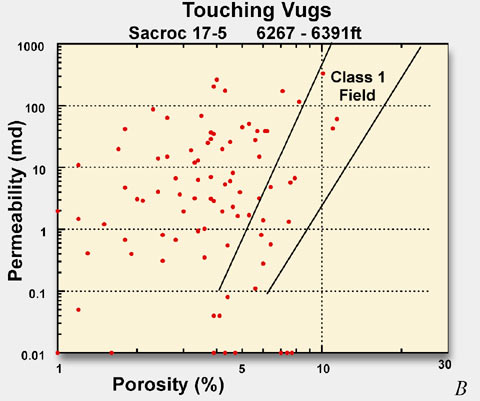
Estimating Permeability in Carbonates Using the Rock-Fabric Method
F. Jerry Lucia
Bureau of Economic Geology
| Design Objectives |
| Glossary |
| Credits |
| Back |
| Top |
| Exit |
 |
 |
 |
|
Rock-Fabric/Petrophysical Relationships Global Interparticle-porosity Permeability Transform Although fabrics
are divided into three petrophysical
classes, in nature there is no boundary between the classes.
Instead, there is a continuum from mudstone
to grainstone
and from 5
To model such a continuum the boundaries of each petrophysical class are assigned a value (0.5, 1.5, 2.5, and 4) (Fig. 14a) and porosity-permeability transforms generated. These transforms were added to the class 1, 2, and 3, transforms and an equation relating permeability to a continuum of class values and interparticle porosity is developed using multiple linear regressions. To avoid confusion, the class values generated by this equation are termed rock-fabric numbers. The resulting global transform is given below. This equation is useful in calculating permeability from wireline logs but is too detailed to be useful for routine classification of visual descriptions.
Mud-dominated
limestones
and fine crystalline mud-dominated dolostones
occupy rock
fabric numbers from 4 to 2.5 (Fig. 14b,c).
The class number decreases with increasing dolomite crystal size
from 5 Unusual Types of Interparticle Porosity Diagenesis can produce unique types of interparticle porosity. Collapse of separate-vug fabrics due to overburden pressure can produce fragments that are properly considered "diagenetic particles". Large dolomite crystals with their centers dissolved can collapse to form pockets of dolomite rims. Leached grainstones can collapse to form intergrain fabrics composed of fragments of dissolved grains. These unusual pore types typically do not cover an extensive area. However, the collapse of extensive cavern systems can produce bodies of collapse breccia that are extensive. Interbreccia-block pores produced by cavern collapse are included in the touching-vug category because they result from the karsting process (Kerans 1989).
Petrophysics of Vuggy Pore Space Petrophysics of Separate-Vug Pore Space The addition of separate-vug porosity to interparticle porosity alters the petrophysical characteristics by altering the manner in which the pore space is connected, all pore space being connected in some fashion. Examples of separate-vug pore space are illustrated in figure 15. Separate vugs are not connected to each other. They are connected only through the interparticle pore space and, although the addition of separate vugs increases total porosity, it does not significantly increase permeability (Lucia 1983). Figure 16a illustrates this principle. Permeability of a moldic grainstone is less than would be expected if all the total porosity were interparticle and, at constant porosity, permeability increases with decreasing separate-vug porosity (Lucia and Conti 1987). The same is true for a large crystalline dolowackestone in that the data are plotted to the left of the class 1 field in proportion to the separate-vug porosity (Lucia 1983).
This principle is also true for intragrain microporosity. Fig. 16b shows data from a Cretaceous ooid grainstone from offshore Brazil with intragrain microporosity and intergrain pore space (Cruz, 1997). The plot shows that the permeability of the grainstone is less than would be expected if all the porosity were interparticle. Petrophysics of Touching-Vug Pore Space Examples of touching-vug pore types are illustrated in Fig. 17. Touching vugs can increase permeability well above what would be expected from the interparticle pore system and are usually considered to be filled with oil in reservoirs. Lucia (1983) illustrated this fact by comparing a plot of fracture permeability versus fracture porosity to the three permeability fields for interparticle porosity (Fig. 18).
This graph shows that permeability in touching-vug pore systems has little relationship to porosity. Typical porosity-permeability cross plots from touching vugs have low (less than 6 percent) porosity and display unorganized scatter. An example is illustrated from a Pennsylvanian reservoir in West Texas (fig. 19).
|
